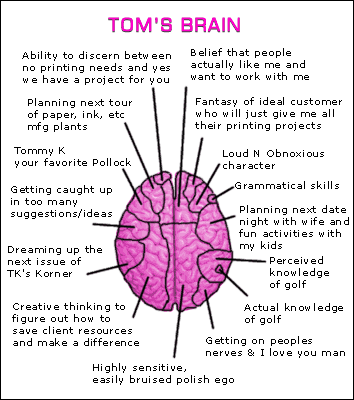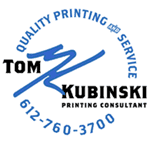Creative Coating Techniques
It has been great to hear from many of you on what topics you'd like to see covered in
future TK's Korner issues. The most common requests were:
- What can I do to make my next project look Unique and Different from all the rest
- How can I snap up my design
- Tell me more about Coating Technique printing
I am happy to tell you about a collection of projects I call, "Coating Technique Binder." This is a variety of one of a kind samples, that are for the most part, a direct
result of a lot of brainstorming sessions and tests done both on/off press over these past 17 years. Some of them are the same project with a couple/few different techniques done to it to see the differences. Truly a great sample for all to view and see just what can/not be done in order to accomplish something new and unique.
 Now, I know it is very difficult to tell/show your customer what you are trying to accomplish with a technique. This is especially true when the types of materials available are quite limited. Yet, we now have a collection of works that allow you to show them just what you are trying to accomplish. In addition, there are a couple of really good Coating Technique books that show options available to you that I have included in this collection. They are filled with all kinds of ideas for you to consider.
Now, I know it is very difficult to tell/show your customer what you are trying to accomplish with a technique. This is especially true when the types of materials available are quite limited. Yet, we now have a collection of works that allow you to show them just what you are trying to accomplish. In addition, there are a couple of really good Coating Technique books that show options available to you that I have included in this collection. They are filled with all kinds of ideas for you to consider.
Some things to keep in mind when considering a coating technique:
- Coatings not only help protect or make certain sections of your projects stand out, but making small changes in the type of coating used can also make all the difference in the world. Note fingerprinting can be an issue when considering coatings. The type of stock and color of ink underneath will usually dictate fingerprinting issues. Please discuss with me so I may direct you down the correct path.
- Varnish can be run either clean/contaminated, wet/dry trap, as spots on their own or right next to each other or as floods. You have gloss, satin or dull options as well.
- Aqueous can be done as a flood in gloss, satin or dull. There are special and very expensive plates available to make Aqueous a spot as well.
- Combining Varnish with an Aqueous together can be done by running one on top of the other for a variety of outcomes. You can use a dry or wet trap option also.
- UV coating is another nice touch that can be done as a spot or flood in gloss or satin. This is the best type of coating to use when protection is needed.
- NEW-Raised Spot UV coating is now available. It combines the look of thermography and UV together. A very nice and different approach for many types of applications. Yet, this technique is so new, that not all the info on what can/not be done, what type of stocks are best, if different types of coatings can run at the same time and if it can be run two sided are known as of yet. I have some really neat samples of this process available.
- Stock choice can also make all the difference. Using a coated sheet-gloss, dull, velvet, satin, matte and using a coating technique can yield very different looks and feel with each combination. However, using an uncoated sheets typically will not give you any real noti
ceable effect or benefit. See Picking the Right Paper.
With that being said, I will attempt to list a few items below of what are included within this collection. Again there are about 50 plus different ones for you to view:
- Same image on the same stock with one having a Satin vs. Gloss Aqueous coating-great example for those who are not sure which to use.
- Subliminal World Globe materializing off of a solid light PMS background using varnishes-great for those subtle differences
- Subliminal Map materializing off of a solid metallic background run with a spot gloss and spot dull contaminated varnish-really shows how you can make it as strong or weak as one would want
- Radio waves coming out from a label pin with a combination of spot & dull varnish versus using only one varnish and contaminating it with different percentages of PMS color-great example to show you each step on what you could accomplish
- Finger holding a globe computer chip over a sky background using a spot varnish and aqueous to make them stand out-really helps you bring the focus to a certain area
- Lots of different Icons on a white background using only different coatings to show them. Here we tried 3 different techniques to show a subtle to very noticeable effect
- Same as number six, but on a purple background and again using 3 different coating techniques to show them
- Metallic duotone halftone image coming together with a coating over it-using metallic as a duotone are always new and different
- Spot dull varnish running underneath a flood aqueous over a solid PMS color showing line art vs. small copy-ideal for Pocket folders or brochure covers
- Spot dull varnish running underneath a flood aqueous over a solid PMS color along with halftones showing Icons in the solid areas
- 4 Color images standing out from other brochure designs/colors using a combination of spot varnish underneath flood aqueous. Makes certain areas stand out from all the rest
- Halftone image run with contaminated varnish over black background to make it stand out on its own and is a technique all to its own
- Double hit of black with a contaminated dull varnish image coming out of background
- Pro
cess black Fingerprint image coming out of a rich black background-cool look
- Different rich black combinations with different process black images coming out of the rich blacks. Really a great sample for heavy coverage black options
Again, it is very difficult to tell you what they are versus seeing them. Just remember that they are available to you for viewing at any time. All you need to do is call me at 651-255-1225 and I'd gladly drop by to discuss what could/not be done as well as show you what I have close to what you are trying to accomplish.
Some other things to keep in mind when using coatings are listed below:
Keep in mind though, that UV burn issues may occur with some PMS colors when aqueous/UV coating.
You will also see how computer to plate technology can give you a variety of different screens/halftones being printed at the same time in one pass with a heavy solid. They will not fill in or require you to use two plates as one would expect by using film. Going further with this, my client was able to see how screens of 90%, 87% and 85% looked with a major solid when they were thinking that their film starting point was going to be around 75%. This was a great tool for them to make sure they got what they wanted.
Printing the same PMS color on a variety of different stocks, can give you a completely different color. I have a great sample that shows how one PMS red color on 15 different stocks can look as if many different colors were used. Something to keep in mind when trying to keep a family looks consistent, yet changing the base stock.
There are also some very helpful Paper Selection Charts available. With these, you will be able to see what type of stock within the same family may yield you the preferred look. What I mean by this is that if you have a cherry pie image, it would be a good choice to go with a warm red paper versus a cool blue shade of white. The later, will make your cherry pie appear a little bit moldy while the other will give you what you want. Or, you will see which of the uncoated, matte, silk, velvet or gloss of the same stock would be a better choice for a certain type of subject and why.
This has been a great tool for me to show. I have had many interesting questions on what I think would work best for this design or product. Together, we will find the best method to go with to make your next printed piece really stand out from the rest.
I have a lot of experience working with these techniques, understand what can/not be done, know how to show yo
u before press what this will look like and how to properly set up the project and run it. This will set your mind at ease and quite possibly make you like a hero on that next project. Hope this has helped.
Referrals are greatly appreciated. If you know someone who I should contact, please let me know.
If you would like to join me on one of our upcoming tours, if there is something that you would like me to address, or if you know of someone who might like to receive TK's Korner, please let me know via e-mail at tkubinski@sextonprinting.com or phone.
Take care and have a great day.
Successfully,
 Tom Kubinski-Printing Consultant
Tom Kubinski-Printing Consultant




 Now, I know it is very difficult to tell/show your customer what you are trying to accomplish with a technique. This is especially true when the types of materials available are quite limited. Yet, we now have a collection of works that allow you to show them just what you are trying to accomplish. In addition, there are a couple of really good Coating Technique books that show options available to you that I have included in this collection. They are filled with all kinds of ideas for you to consider.
Now, I know it is very difficult to tell/show your customer what you are trying to accomplish with a technique. This is especially true when the types of materials available are quite limited. Yet, we now have a collection of works that allow you to show them just what you are trying to accomplish. In addition, there are a couple of really good Coating Technique books that show options available to you that I have included in this collection. They are filled with all kinds of ideas for you to consider.